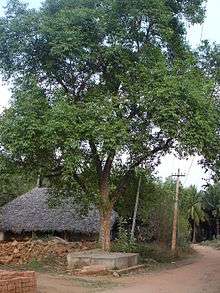Racchabanda
A racchabanda (or raccha banda) is a raised platform typically built under the shade of a huge tree, common in Andhra Pradesh.[1][2] The tree may be Ficus benghalensis or Sacred fig or Jambul or Tamarind. The platforms may be built with sedimentary rocks or bricks or cement. Historically Racchabandas came into existence in India before the Medieval period. Rachabandas can also be found in several rural villages throughout India.

Importance
Racchabanda is a traditional get together place for the villagers to discuss their social problems, economic issues, and other disputes.[3] Head of a village who is called munsabu (mostly elder males) sits on racchabanda to give solutions for several problems and settle various disputes among villagers. Racchabandas act as local courts which are always confined to the limits of their respective villages.[4]
Modern status
In modern times, racchabandas are becoming extinct due to urbanization.
References
- India. Office of the Registrar General. Census of India, 1961: Andra Pradesh. Census of India, 1961. Manager of Publications. p. 189. Retrieved 15 September 2018.
- The Eastern Anthropologist. Ethnographic and Folk Culture Society. 1990. p. 262. Retrieved 15 September 2018.
- Deo, S.B.; Margabandhu, C.; Ramachandran, K.S. (1996). Spectrum of Indian culture: Professor S.B. Deo felicitation volume. Agam Indological series. Agam Kala Prakashan. p. 154. ISBN 978-81-7320-022-9. Retrieved 15 September 2018.
- Rao, M.S.; Reddi, M.S. (2007). Tribal Development: Issues and Prospects. Associated Publishers. p. 53. ISBN 978-81-8429-044-8. Retrieved 15 September 2018.